
BL 6 inch Mk VII naval gun
Encyclopedia
The BL 6 inch Gun Mark VII (and the related Mk VIII) was a British
naval gun
dating from 1899, which was mounted on a heavy traveling carriage in 1915 for British Army
service to become one of the main heavy field guns in the First World War
, and also served as one of the main coast defence guns throughout the British Empire
until the 1950s.
 The gun was introduced on the Formidable class battleship
The gun was introduced on the Formidable class battleship
s of 1898 (commissioned September 1901) and went on to equip many capital ship
s, cruiser
s, monitor
s, and smaller ships such as the Insect class gunboat
which served throughout World War II
.
Mk VIII in Naval service was identical to Mk VII, except that the breech opened to the left instead of to the right, for use as the left gun in twin turrets.
Guns were mounted in the following ships :
In World War II the gun was used to arm British troop ships and armed merchant cruisers.
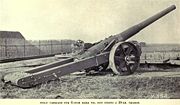 They were first sent to France in 1915 mounted on improvised rectangular-frame field carriages designed by Admiral Percy Scott
They were first sent to France in 1915 mounted on improvised rectangular-frame field carriages designed by Admiral Percy Scott
, based on the design he had improvised for 4.7 inch guns
in the Second Boer War
, and were successful.
However, elevation and hence range was limited with the Scott carriages so a proper carriage, MK II, was introduced early in 1916, allowing elevation to 22°. Carriages Mks III, V and VI also appeared.
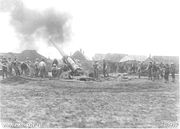
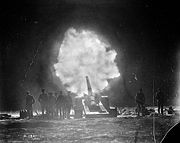 It was operated by the Royal Garrison Artillery
It was operated by the Royal Garrison Artillery
, as were all the larger guns, in World War I
, in batteries of 4 guns.
Following its successful employment in the Battle of the Somme its role was defined as counter-battery fire and also they "were most effective for neutralising defenses and for wire cutting with fuze 106
[a new fuze which reliably burst instantly above ground on even slight contact, instead of forming craters]", also for long-range fire against "targets in depth".
It was superseded by the lighter and longer-range BL 6 inch Gun Mk XIX which was introduced from October 1916 but the Mk VII remained in service to the end of World War I
.
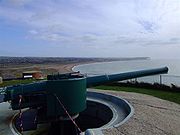
 The 6-inch Mk VII gun, together with the 9.2 inch Mk X gun
The 6-inch Mk VII gun, together with the 9.2 inch Mk X gun
, provided the main coast defence throughout the British Empire, from the early 1900s until the abolition of coast artillery in the 1950s. Many guns were specially built for army coast defence use, and following the decommissioning of many obsolete cruisers and battleships after World War I
, their 6-inch Mk VII guns were also recycled for coast defence.
103 of these guns were in service in World War I in coastal defences around the UK. Some of these, together with others at ports around the wider British Empire, played an important defence role in World War II
and remained in service until the 1950s.
A number of new similar guns with stronger barrels which allowed more powerful cordite charges to be used were manufactured for coast defence during World War II, and were designated 6-inch BL Mark XXIV.
on 16 December 1914, a notable action was fought by Durham Company RGA of the Territorial Force
at Heugh
(2 guns) and Lighthouse (1 gun) batteries defending Hartlepool
. They duelled with the German battlecruisers Seydlitz
and Moltke (11 inch guns) and Blücher
(8.2 inch), firing 112 rounds and scoring 7 hits. The battlecruisers fired a total of 1,150 rounds at the town and the batteries causing 112 civilians and 7 military killed.
United Kingdom
The United Kingdom of Great Britain and Northern IrelandIn the United Kingdom and Dependencies, other languages have been officially recognised as legitimate autochthonous languages under the European Charter for Regional or Minority Languages...
naval gun
Naval artillery
Naval artillery, or naval riflery, is artillery mounted on a warship for use in naval warfare. Naval artillery has historically been used to engage either other ships, or targets on land; in the latter role it is currently termed naval gunfire fire support...
dating from 1899, which was mounted on a heavy traveling carriage in 1915 for British Army
British Army
The British Army is the land warfare branch of Her Majesty's Armed Forces in the United Kingdom. It came into being with the unification of the Kingdom of England and Scotland into the Kingdom of Great Britain in 1707. The new British Army incorporated Regiments that had already existed in England...
service to become one of the main heavy field guns in the First World War
World War I
World War I , which was predominantly called the World War or the Great War from its occurrence until 1939, and the First World War or World War I thereafter, was a major war centred in Europe that began on 28 July 1914 and lasted until 11 November 1918...
, and also served as one of the main coast defence guns throughout the British Empire
British Empire
The British Empire comprised the dominions, colonies, protectorates, mandates and other territories ruled or administered by the United Kingdom. It originated with the overseas colonies and trading posts established by England in the late 16th and early 17th centuries. At its height, it was the...
until the 1950s.
Background
The gun superseded the QF 6 inch gun of the 1890s, a period during which the Royal Navy had evaluated QF technology (i.e. loading propellant charges in brass cartridge cases) for all classes of guns up to 6 inch to increase rates of fire. BL Mk VII returned to loading charges in silk bags after it was determined that with new single-action breech mechanisms a 6-inch BL gun could be loaded, vent tube inserted and fired as quickly as a QF 6 inch gun. Cordite charges in silk bags stored for a BL gun were also considered to represent a considerable saving in weight and magazine space compared to the bulky brass QF cartridge cases.Naval gun

Formidable class battleship
The Royal Navy's Formidable class battleships was an eight-ship class of pre-dreadnoughts designed by Sir William White and built in the late 1890s...
s of 1898 (commissioned September 1901) and went on to equip many capital ship
Capital ship
The capital ships of a navy are its most important warships; they generally possess the heaviest firepower and armor and are traditionally much larger than other naval vessels...
s, cruiser
Cruiser
A cruiser is a type of warship. The term has been in use for several hundreds of years, and has had different meanings throughout this period...
s, monitor
Monitor (warship)
A monitor was a class of relatively small warship which was neither fast nor strongly armoured but carried disproportionately large guns. They were used by some navies from the 1860s until the end of World War II, and saw their final use by the United States Navy during the Vietnam War.The monitors...
s, and smaller ships such as the Insect class gunboat
Insect class gunboat
The Insect class patrol boats were a class of small, but well-armed Royal Navy ships designed for use in shallow rivers or inshore. They were intended for use on the Danube...
which served throughout World War II
World War II
World War II, or the Second World War , was a global conflict lasting from 1939 to 1945, involving most of the world's nations—including all of the great powers—eventually forming two opposing military alliances: the Allies and the Axis...
.
Mk VIII in Naval service was identical to Mk VII, except that the breech opened to the left instead of to the right, for use as the left gun in twin turrets.
Guns were mounted in the following ships :
- Formidable class battleshipsFormidable class battleshipThe Royal Navy's Formidable class battleships was an eight-ship class of pre-dreadnoughts designed by Sir William White and built in the late 1890s...
laid down 1898 - Cressy class armoured cruisersCressy class cruiserThe Cressy class cruiser was a class of six armoured cruisers launched between December 1899 and May 1901, for the Royal Navy.-Service:...
laid down 1898 - Duncan class battleships laid down 1899
- Drake class armoured cruisersDrake class cruiserThe Drake-class was a four-ship class of armoured cruisers built around 1900 for the Royal Navy.-Design:The class were enlarged versions of the Cressy class.-History:The ships served in the First World War with only two surviving it...
laid down 1899 - Monmouth class armoured cruisersMonmouth class cruiserThe Monmouth-class was a ten-ship class of 10,000 ton armoured cruisers built around 1901 to 1903 for the Royal Navy and designed specifically for commerce protection...
laid down 1899 - Challenger second class protected cruisersChallenger class cruiserThe Challenger class cruisers were a two-ship class of second class protected cruisers of the Royal Navy and Royal Australian Navy.-Ships: - Sold 1920 - To Australia 1912 as HMAS Encounter, renamed Penguin 1923, scuttled 1932.-References:...
laid down in 1901 - King Edward VII class battleships CommonwealthHMS Commonwealth (1903)HMS Commonwealth, was a of the British Royal Navy. Like all ships of the class she was named after an important part of the British Empire, namely the Commonwealth of Australia.-Technical characteristics:...
, DominionHMS Dominion (1903)HMS Dominion was a of the Royal Navy. Like all ships of the class she was named after an important part of the British Empire, namely the Dominion of Canada. She has been the only ship of the Royal Navy to bear the name Dominion.-Technical characteristics:HMS Dominion was ordered under the 1902...
, HindustanHMS Hindustan (1903)HMS Hindustan was a King Edward VII class pre-dreadnought battleship of the Royal Navy . Like all ships of the class she was named after an important part of the British Empire, namely the Indian Empire.-Technical characteristics:...
, King Edward VIIHMS King Edward VIIHMS King Edward VII, named after King Edward VII, was the lead ship of her class of Royal Navy pre-dreadnought battleships.-Technical characteristics:HMS King Edward VII was laid down at Devonport Dockyard on 8 March 1902...
, New ZealandHMS New Zealand (1904)HMS New Zealand was a King Edward VII class battleship of the Royal Navy. Like all ships of the class she was named after an important part of the British Empire, namely New Zealand...
laid down 1902 - Devonshire class armoured cruisersDevonshire class cruiser (1903)The Devonshire class was a class of six armoured cruisers of the British Royal Navy, launched in 1903–1904 at a cost of around £850,000 each....
laid down 1902 - HMS TigerHMS Tiger (1913)The 11th HMS Tiger was a battlecruiser of the Royal Navy, built by John Brown and Company, Clydebank, Scotland, and launched in 1913. Tiger was the most heavily armoured battlecruiser of the Royal Navy at the start of the First World War although she was still being finished when the war began...
, battlecruiser laid down 1912 - Centurion class battleshipsCenturion class battleshipThe Centurion class battleships were second-class pre-dreadnought battleships of the Royal Navy designed for service on distant stations.-Description:...
as re-gunned in 1902 - Iron Duke class battleshipsIron Duke class battleshipThe Iron Duke-class was a group of four dreadnought battleships built for the British Royal Navy before the First World War. The class comprised four ships: , , , and...
laid down 1912 - Humber class monitorHumber class monitorThe Humber class monitors were three large gunboats under construction for the Brazilian Navy in Britain in 1913. Designed for service on the Amazon River, the ships were of shallow draft and heavy armament and were ideally suited to inshore, riverine and coastal work but flawed for service at sea,...
s as re-gunned in 1914 with guns from HMS MontaguHMS Montagu (1901)HMS Montagu was a Pre-dreadnought battleship of the British Royal Navy.In May 1906 in thick fog, she was wrecked on Lundy Island, fortunately without loss of life.... - M15 class monitorM15 class monitorThe M15-class comprised fourteen monitors of the Royal Navy, all built and launched during 1915.- Design :The ships of this class were ordered in March, 1915, as part of the Emergency War Programme of ship construction...
M27 of 1915 - Insect class gunboatInsect class gunboatThe Insect class patrol boats were a class of small, but well-armed Royal Navy ships designed for use in shallow rivers or inshore. They were intended for use on the Danube...
s of 1915
In World War II the gun was used to arm British troop ships and armed merchant cruisers.
World War I field gun

Percy Scott
Admiral Sir Percy Moreton Scott, 1st Baronet GCB KCVO was a British Royal Navy officer and a pioneer in modern naval gunnery.-Early years:...
, based on the design he had improvised for 4.7 inch guns
QF 4.7 inch Gun Mk I - IV
The QF 4.7 inch Gun Mks I, II, III, and IV were a family of United-Kingdom 120-mm naval and coast defence guns of 1888 and 1890s which served with the navies of various countries. They were also mounted on various wheeled carriages to provide the British Army with a long range gun...
in the Second Boer War
Second Boer War
The Second Boer War was fought from 11 October 1899 until 31 May 1902 between the British Empire and the Afrikaans-speaking Dutch settlers of two independent Boer republics, the South African Republic and the Orange Free State...
, and were successful.
However, elevation and hence range was limited with the Scott carriages so a proper carriage, MK II, was introduced early in 1916, allowing elevation to 22°. Carriages Mks III, V and VI also appeared.


Royal Garrison Artillery
The Royal Garrison Artillery was an arm of the Royal Artillery that was originally tasked with manning the guns of the British Empire's forts and fortresses, including coastal artillery batteries, the heavy gun batteries attached to each infantry division, and the guns of the siege...
, as were all the larger guns, in World War I
World War I
World War I , which was predominantly called the World War or the Great War from its occurrence until 1939, and the First World War or World War I thereafter, was a major war centred in Europe that began on 28 July 1914 and lasted until 11 November 1918...
, in batteries of 4 guns.
Following its successful employment in the Battle of the Somme its role was defined as counter-battery fire and also they "were most effective for neutralising defenses and for wire cutting with fuze 106
No. 106 Fuze
Number 106 Fuze was the first British instantaneous percussion artillery fuze, first tested in action in late 1916 and deployed in volume in early 1917.-Background:...
[a new fuze which reliably burst instantly above ground on even slight contact, instead of forming craters]", also for long-range fire against "targets in depth".
It was superseded by the lighter and longer-range BL 6 inch Gun Mk XIX which was introduced from October 1916 but the Mk VII remained in service to the end of World War I
World War I
World War I , which was predominantly called the World War or the Great War from its occurrence until 1939, and the First World War or World War I thereafter, was a major war centred in Europe that began on 28 July 1914 and lasted until 11 November 1918...
.
Coast defence gun


BL 9.2 inch gun Mk IX - X
The BL 9.2 inch guns Mk IX and Mk X were British 46.7 calibres naval and coast defence guns in service from 1899 to the 1950s. They had possibly the longest, most varied and successful service history of any British heavy ordnance.-History:...
, provided the main coast defence throughout the British Empire, from the early 1900s until the abolition of coast artillery in the 1950s. Many guns were specially built for army coast defence use, and following the decommissioning of many obsolete cruisers and battleships after World War I
World War I
World War I , which was predominantly called the World War or the Great War from its occurrence until 1939, and the First World War or World War I thereafter, was a major war centred in Europe that began on 28 July 1914 and lasted until 11 November 1918...
, their 6-inch Mk VII guns were also recycled for coast defence.
103 of these guns were in service in World War I in coastal defences around the UK. Some of these, together with others at ports around the wider British Empire, played an important defence role in World War II
World War II
World War II, or the Second World War , was a global conflict lasting from 1939 to 1945, involving most of the world's nations—including all of the great powers—eventually forming two opposing military alliances: the Allies and the Axis...
and remained in service until the 1950s.
A number of new similar guns with stronger barrels which allowed more powerful cordite charges to be used were manufactured for coast defence during World War II, and were designated 6-inch BL Mark XXIV.
Notable actions
In the German raid on Scarborough, Hartlepool and WhitbyRaid on Scarborough, Hartlepool and Whitby
The raid on Scarborough, Hartlepool and Whitby, which took place on 16 December 1914, was an attack by the Imperial German Navy on the British seaport towns of Scarborough, Hartlepool, West Hartlepool, and Whitby. The attack resulted in 137 fatalities and 592 casualties, many of which were civilians...
on 16 December 1914, a notable action was fought by Durham Company RGA of the Territorial Force
Territorial Force
The Territorial Force was the volunteer reserve component of the British Army from 1908 to 1920, when it became the Territorial Army.-Origins:...
at Heugh
Heugh Battery
The Heugh Gun Battery is located on the Headland at Hartlepool, County Durham, England.- History :Heugh Battery was one of three erected in 1860 to protect the fast growing port of Hartlepool. Heugh and Lighthouse Battery were placed close by the lighthouse and armed with four and two 68pr...
(2 guns) and Lighthouse (1 gun) batteries defending Hartlepool
Hartlepool
Hartlepool is a town and port in North East England.It was founded in the 7th century AD, around the Northumbrian monastery of Hartlepool Abbey. The village grew during the Middle Ages and developed a harbour which served as the official port of the County Palatine of Durham. A railway link from...
. They duelled with the German battlecruisers Seydlitz
SMS Seydlitz
SMS Seydlitz"SMS" stands for "Seiner Majestät Schiff", or "His Majesty's Ship" in German. was a 25,000-metric ton battlecruiserAdmiral Alfred von Tirpitz referred to the ship as a large cruiser in his annual budgets in an attempt to reduce opposition from the Reichstag; the ship was not referred...
and Moltke (11 inch guns) and Blücher
SMS Blücher
SMS Blücher was the last armored cruiser to be built by the German Imperial Navy . She was designed to match what German intelligence incorrectly believed to be the specifications of the British s...
(8.2 inch), firing 112 rounds and scoring 7 hits. The battlecruisers fired a total of 1,150 rounds at the town and the batteries causing 112 civilians and 7 military killed.
World War I Ammunition
 |
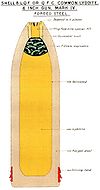 |
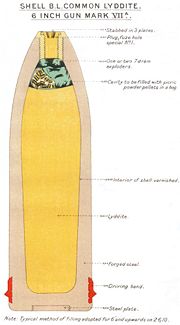 |
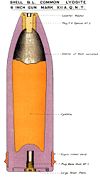 |
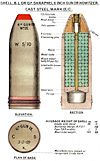 |
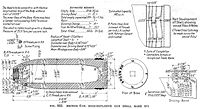 |
Cordite Cordite is a family of smokeless propellants developed and produced in the United Kingdom from 1889 to replace gunpowder as a military propellant. Like gunpowder, cordite is classified as a low explosive because of its slow burning rates and consequently low brisance... Cartridge |
Surviving examples
- Rotunda, Royal Artillery Museum, London
- A coast defence gun at Newhaven Fort, Sussex, UK
- A gun mounted on the 1904 coast defence emplacement at New Tavern FortNew Tavern FortNew Tavern Fort was built at Gravesend, Kent, England in the 1780s against the threat of invasion from France. It was one of the Palmerston Forts, also known as Royal Commission forts. The fort was extensively rebuilt by General Gordon about 1870. It was regunned in 1904...
, Gravesend, UK - 2 coast defence Mk 7 guns at Fort Dunree, Lough Swilly, Ireland
- A gun on field carriage at The Front Museum, Lappohja, Finland
- Fort Ogilvie, Point Pleasant Park, Halifax, Nova Scotia
- VSM gun No. 1553 dated 1901 at Princess Royal Fortress, Albany, Western AustraliaAlbany, Western AustraliaAlbany is a port city in the Great Southern region of Western Australia, some 418 km SE of Perth, the state capital. As of 2009, Albany's population was estimated at 33,600, making it the 6th-largest city in the state....
. Obtained from Bermuda during restoration of the site in the 1980s. - Barrel 1489 which fired the first Australian shot of WWI, and 1317 which fired the first Australian shot of WWII at Fort NepeanFort NepeanFort Nepean is a former defensive facility occupying part of Point Nepean, Victoria, Australia. It was part of a network of fortifications, commanded from Fort Queenscliff, protecting the narrow entrance to Port Phillip.- Background :...
, Victoria - Mk VII gun dated 1902 at Ile aux Aigrettes, Mauritus
- Fort SilosoFort SilosoFort Siloso is the sole restored coastal gun battery from the twelve such batteries which made up "Fortress Singapore" at the start of World War II...
at Sentosa Island, Singapore - http://www.southpacificphotography.com/photos.cfm/PhotoId/316/momi-gun-coral-coast.html Momi, Vuda, Batteries, Viti Levu, Fiji Islands. One of the barrels is #1266 from 1900
External links
- Ken Musgrave, Diagram of BL 6inch Mk VII Gun on Mk. 2 Carriage at Landships (scroll to bottom of page)
- Per Finsted, Om den engelske 6-tommers feltkanon 1914-1940 (in Danish)

